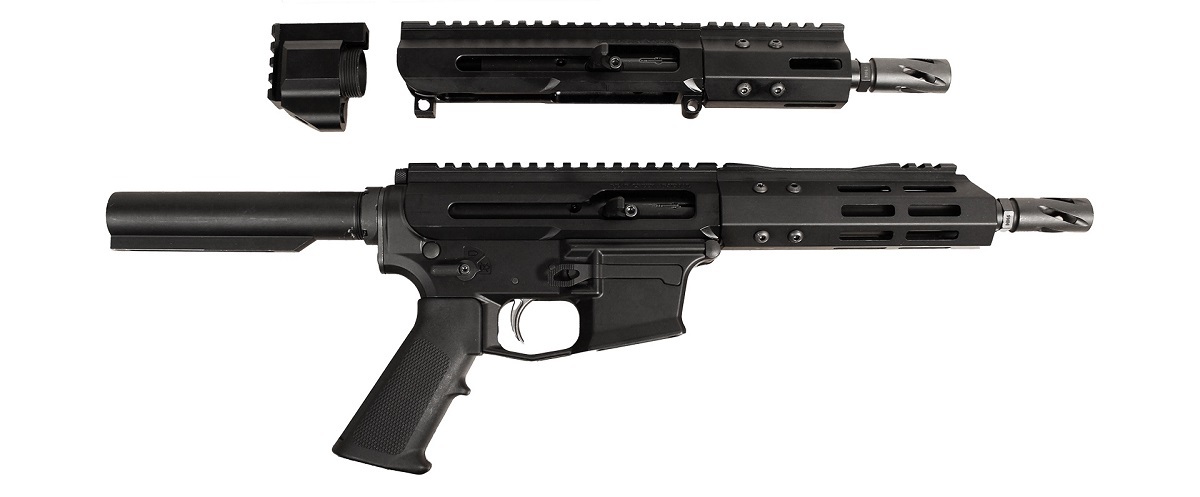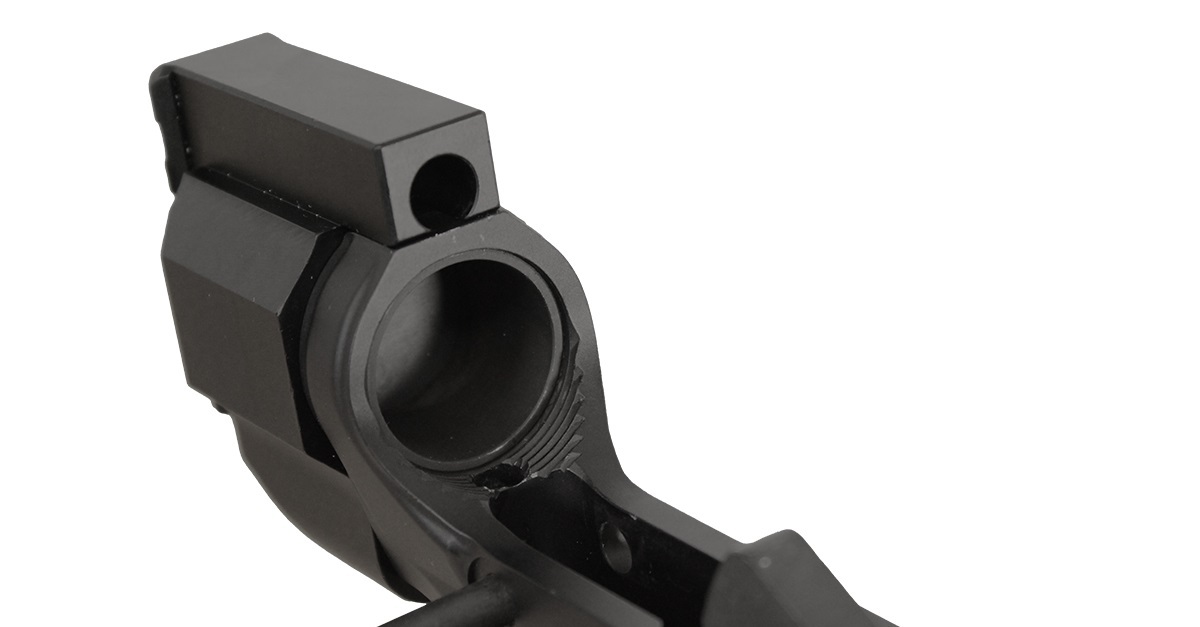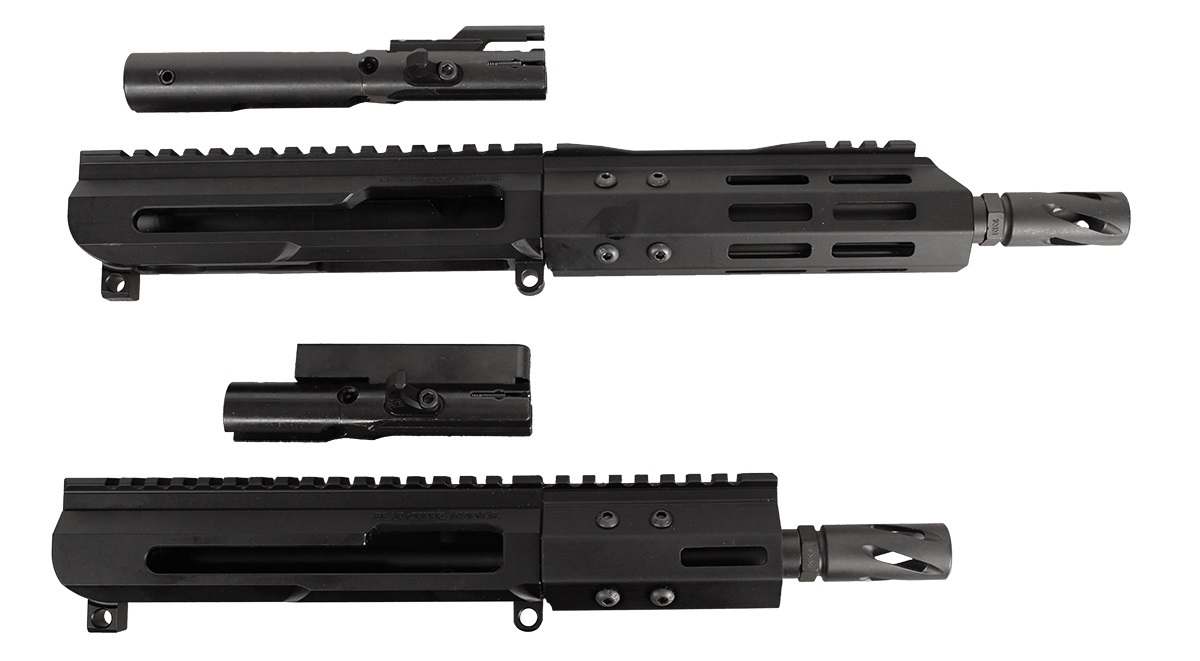How the Bufferless AR9 Works
Posted by Gunbuilders.com on May 27th 2025
The 9mm AR, officially called the AR9, provides a compact solution that allows the AR platform to ditch its gas system and, more importantly, its buffer system. One of the stubborn pains the AR-15 and its many variants suffer from is the buffer tube. It's necessary for the bolt carrier group to cycle properly. Well, it was necessary until upper receivers with self-contained recoil springs and operating rods became a thing.
Since we started selling our own bufferless AR9 pistol upper, we've received a lot of questions about how it works, and what lowers and other parts its compatible with.
How The Bufferless AR9 Works

As shown above, the bufferless upper is actually a two-part system. The upper itself contains the modified bolt, while the rear of the upper interfaces with an end cap that replaces the buffer system found on the lower receiver.
The Bufferless End Cap Assembly

The end cap assembly acts as the backstop for the bolt, providing a surface for the rear of the bolt to impact before it returns to battery. Inside the end cap you will find a short tube that looks like a buffer tube. Inside this tube is a damper to cushion the impact of the bolt.

The tube, which threads into the lower's existing buffer tube housing, also has a threaded hole that allows the end cap to be secured to the tube itself. The end cap on this model provides a vertical Picatinny rail for attaching a folding stock.

The end cap also acts as a host for the operating rod and recoil spring. The op rod and spring interfaces with the modified bolt to act as the replacement for the AR's usual buffer and recoil spring.
The Bufferless Bolt Assembly

The bufferless bolt assembly replaces the usual gas key and, in the case of the 9mm bolt, the sled that's installed to align the bolt face with the chamber. In place of these fixtures, the bufferless bolt uses a sled with a hole that interfaces with the operating rod and recoil spring inside the upper receiver.

In addition to the modified sled, the bufferless bolt is physically shorter. The sled contains added mass to counteract the loss of weight by the shortened bolt. This bolt's shortened length is what allows it to reciprocrate fully inside the upper receiver without the need for a standard buffer tube.

The above comparison illustrates why the standard AR platform requires the buffer tube. The typical bolt carrier group's length is nearly the same as the length of the upper receiver. Only by reducing the bolt length by approximately 50%, and compensating for the loss of mass with a large sled, can the buffer be eliminated, and its recoil spring's and buffer's operations moved to function exclusively within the upper receiver itself.
Bufferless AR FAQs
We get a lot of other questions about the bufferless AR platform -- how it works, what parts work with it, and some other questions. Let's answer them:
Q: Does the bufferless AR require a custom lower receiver?
A: No. The standard lower receiver works with the bufferless upper assembly. The bufferless upper's modified end cap is made to function with the standard lower's existing buffer tube housing and threads. The bufferless upper attaches directly to any existing lower receiver; it retains the standard pivot and takedown pin holes.
Q: Does the lower receiver require any custom parts to function with the bufferless upper?
A: No. All bufferless uppers -- whether 9mm, or some other caliber, like 5.56 NATO or .223 Remington -- are designed to function with existing fire control components, including the AR's standard hammer, trigger, safety, disconnector, and front and rear takedown and pivot pins. Note that without a buffer installed, the lower receiver does not make use of the buffer retainer found in the standard lower parts kit.
Q: What kind of charging handle does a bufferless upper use?
A: The standard charging handle is not utilized with a bufferless upper. The standard handle requires the buffer tube to function properly. Instead, bufferless uppers use side-charging handles that are contained within the upper receiver itself. Some models have non-reciprocating handles; the 9mm upper shown in this guide uses a reciprocating handle bolted directly to the bolt's body.
Q: Can an existing upper receiver be converted to function as a bufferless upper?
A: No. The modified bolt carrier groups found in bufferless uppers require different dimensions within their upper receivers to seat and function. The upper in this guide has a wider channel cut for the sled atop the bolt; this channel would not accommodate the standard gas carrier key.
Q: Do bufferless uppers require special barrels or handguards?
A: No. The barrel extension housing on bufferless uppers are the same as those found on conventional upper receivers. This means the standard AR-type barrel, barrel nut, and handguard is still used on these modified receivers.
Q: Can you convert a bufferless upper back into a buffer tube-equipped setup?
A: No. Converting the bufferless upper into an assembly that would use a buffer tube would require removing and replacing the bufferless bolt with a standard bolt, which would not fit inside the modified upper.
DISCLAIMER: If you are new to the world of DIY gun building, you likely have a lot of questions and rightfully so. It’s an area that has a lot of questions that, without the correct answers, could have some serious implications. At GunBuilders.com, we are by no means providing this content on our website to serve as legal advice or legal counsel. We encourage each and every builder to perform their own research around their respective State laws as well as educating themselves on the Federal laws. When performing your own research, please be sure that you are getting your information from a reliable source.

